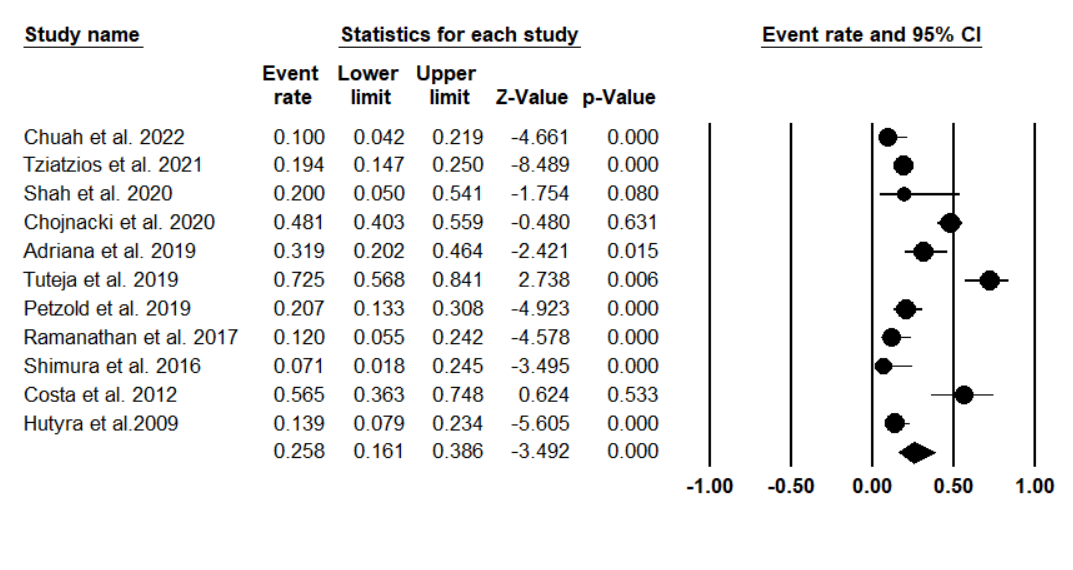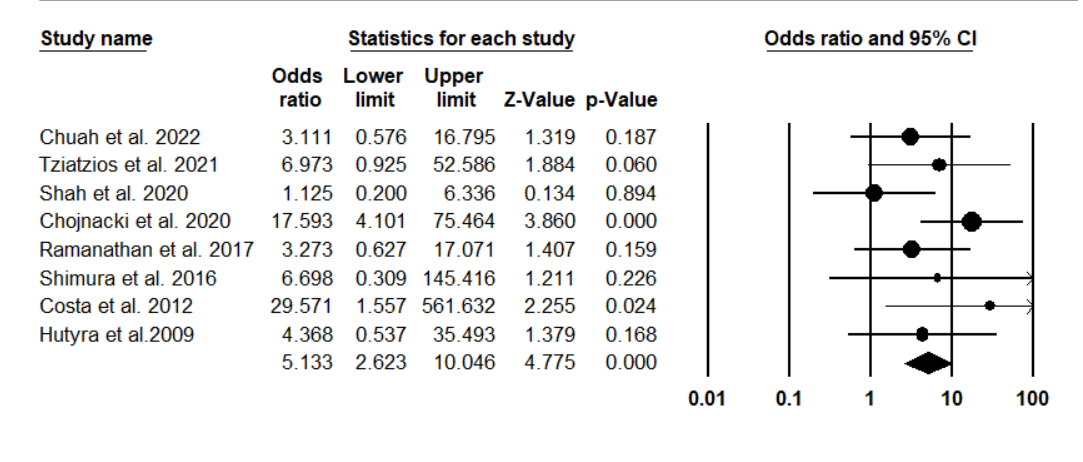Monday Poster Session
Category: Functional Bowel Disease
P2938 - Small Intestinal Bacterial Overgrowth in Functional Dyspepsia and Its Subtypes: A Systematic Review and Meta-Analysis
Monday, October 27, 2025
10:30 AM - 4:00 PM PDT
Location: Exhibit Hall

Andy M. Thai, MD (he/him/his)
Alameda Health System
Fremont, CA
Presenting Author(s)
Andy M. Thai, MD1, Daniel Faradji, MD2, Dillon Drab, MD2, Steve Lander, MD3, Christina Chou, MD4, Claudio Tombazzi, MD5
1Alameda Health System, Fremont, CA; 2Methodist Dallas Medical Center, Dallas, TX; 3University of Tennessee Health Science Center, Memphis, TN; 4Alameda Health System, Oakland, CA; 5VA Memphis Health Care, Memphis, TN
Introduction: Functional dyspepsia disease (FD) is a common condition affecting the gastroduodenal area, characterized mainly by the symptoms of postprandial fullness or epigastric pain that could not be attributed to any underlying organic disease for a period of six months. Small intestinal bacterial overgrowth (SIBO) is a medical condition where there are alterations in the quantity and distribution of gut microbiota. The SIBO prevalence in FD and its subtypes remains unclear, with conflicting estimates. Hence, this systematic review was conducted to provide a pooled prevalence of SIBO in FD patients, and compare it to healthy individuals by odds ratio, in addition to investigating the variations in the techniques used for SIBO diagnosis across the studies.
Methods: Four databases were reviewed to identify relevant literature. Studies reporting the SIBO prevalence in FD or giving sufficient data to calculate it were included. Pooled prevalence was calculated for all studies, and an odds ratio was calculated for the studies having a healthy control group. Sensitivity analysis, publication bias assessment, and quality assessment were done. Subgroup analysis was done to examine variations by regions and diagnostic criteria.
Results: Eleven studies with 792 FD patients from ten countries were identified. The pooled SIBO prevalence in FD subjects was 25.8% (95%CI: 16.1%–38.6%, I² = 90.16%). As pooled from eight case-control studies, FD patients reported significantly higher odds of SIBO when put in comparison with healthy subjects (OR = 5.13, 95%CI: 2.62–10.06, I² = 10.65%). Subgroup analysis revealed higher prevalence estimates when using lactulose as a substrate for hydrogen breath test (HBT) compared to glucose. Grouping by region identified the Americas as the region with the highest reported prevalence. There are variations in the diagnostic techniques and parameters across the studies. Sensitivity analyses confirmed the robustness of the findings, and no publication-related bias was found.
Discussion: SIBO is prevalent among FD patients, and FD patients are at higher risk to have SIBO when compared to controls. No major differences were found in SIBO prevalence for FD subtypes. Future research should standardize diagnostic parameters to provide more accurate estimates.

Figure: The Forest plot visual representation of the prevalence of SIBO in FD patients, using a 95 % confidence interval

Figure: Odds ratio for SIBO in FD patients with 95% confidence interval
Disclosures:
Andy Thai indicated no relevant financial relationships.
Daniel Faradji indicated no relevant financial relationships.
Dillon Drab indicated no relevant financial relationships.
Steve Lander indicated no relevant financial relationships.
Christina Chou indicated no relevant financial relationships.
Claudio Tombazzi indicated no relevant financial relationships.
Andy M. Thai, MD1, Daniel Faradji, MD2, Dillon Drab, MD2, Steve Lander, MD3, Christina Chou, MD4, Claudio Tombazzi, MD5. P2938 - Small Intestinal Bacterial Overgrowth in Functional Dyspepsia and Its Subtypes: A Systematic Review and Meta-Analysis, ACG 2025 Annual Scientific Meeting Abstracts. Phoenix, AZ: American College of Gastroenterology.
1Alameda Health System, Fremont, CA; 2Methodist Dallas Medical Center, Dallas, TX; 3University of Tennessee Health Science Center, Memphis, TN; 4Alameda Health System, Oakland, CA; 5VA Memphis Health Care, Memphis, TN
Introduction: Functional dyspepsia disease (FD) is a common condition affecting the gastroduodenal area, characterized mainly by the symptoms of postprandial fullness or epigastric pain that could not be attributed to any underlying organic disease for a period of six months. Small intestinal bacterial overgrowth (SIBO) is a medical condition where there are alterations in the quantity and distribution of gut microbiota. The SIBO prevalence in FD and its subtypes remains unclear, with conflicting estimates. Hence, this systematic review was conducted to provide a pooled prevalence of SIBO in FD patients, and compare it to healthy individuals by odds ratio, in addition to investigating the variations in the techniques used for SIBO diagnosis across the studies.
Methods: Four databases were reviewed to identify relevant literature. Studies reporting the SIBO prevalence in FD or giving sufficient data to calculate it were included. Pooled prevalence was calculated for all studies, and an odds ratio was calculated for the studies having a healthy control group. Sensitivity analysis, publication bias assessment, and quality assessment were done. Subgroup analysis was done to examine variations by regions and diagnostic criteria.
Results: Eleven studies with 792 FD patients from ten countries were identified. The pooled SIBO prevalence in FD subjects was 25.8% (95%CI: 16.1%–38.6%, I² = 90.16%). As pooled from eight case-control studies, FD patients reported significantly higher odds of SIBO when put in comparison with healthy subjects (OR = 5.13, 95%CI: 2.62–10.06, I² = 10.65%). Subgroup analysis revealed higher prevalence estimates when using lactulose as a substrate for hydrogen breath test (HBT) compared to glucose. Grouping by region identified the Americas as the region with the highest reported prevalence. There are variations in the diagnostic techniques and parameters across the studies. Sensitivity analyses confirmed the robustness of the findings, and no publication-related bias was found.
Discussion: SIBO is prevalent among FD patients, and FD patients are at higher risk to have SIBO when compared to controls. No major differences were found in SIBO prevalence for FD subtypes. Future research should standardize diagnostic parameters to provide more accurate estimates.

Figure: The Forest plot visual representation of the prevalence of SIBO in FD patients, using a 95 % confidence interval

Figure: Odds ratio for SIBO in FD patients with 95% confidence interval
Disclosures:
Andy Thai indicated no relevant financial relationships.
Daniel Faradji indicated no relevant financial relationships.
Dillon Drab indicated no relevant financial relationships.
Steve Lander indicated no relevant financial relationships.
Christina Chou indicated no relevant financial relationships.
Claudio Tombazzi indicated no relevant financial relationships.
Andy M. Thai, MD1, Daniel Faradji, MD2, Dillon Drab, MD2, Steve Lander, MD3, Christina Chou, MD4, Claudio Tombazzi, MD5. P2938 - Small Intestinal Bacterial Overgrowth in Functional Dyspepsia and Its Subtypes: A Systematic Review and Meta-Analysis, ACG 2025 Annual Scientific Meeting Abstracts. Phoenix, AZ: American College of Gastroenterology.
